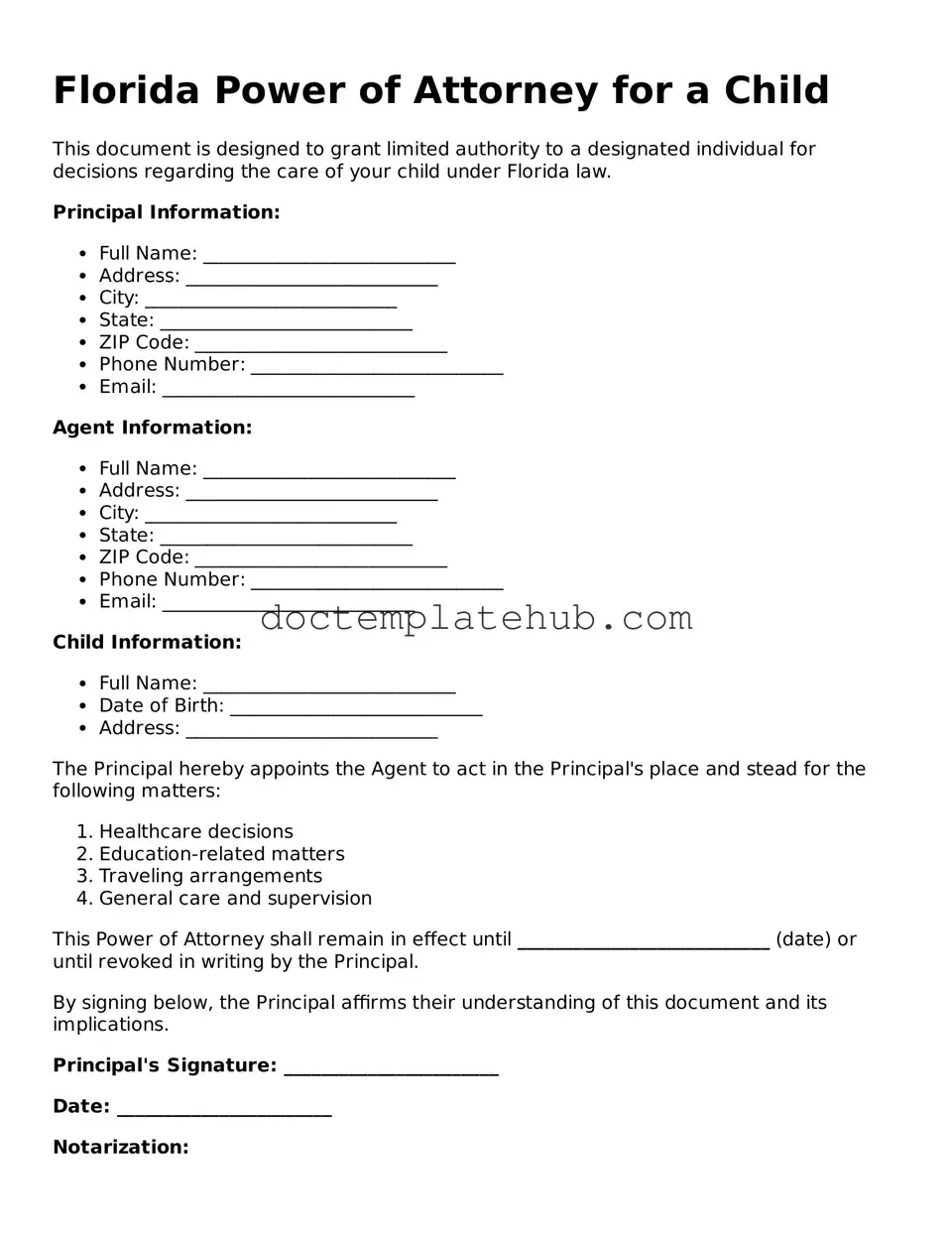The Florida Power of Attorney for a Child form shares similarities with a General Power of Attorney. Both documents allow one person to grant another individual the authority to make decisions on their behalf. In the case of a General Power of Attorney, the scope can be broad, covering financial and legal matters, while the Power of Attorney for a Child is specifically tailored to address the needs and decisions related to a child’s welfare, education, and healthcare. This targeted focus on child-related issues makes it a specialized version of the more general document.
When considering legal agreements involving minors, it is essential to understand the nuances of various documents, including the Hold Harmless Agreement form. This form is designed to protect parties from liability and is often referenced in various contexts, including the management of risks related to childcare activities. For more comprehensive templates, you can visit smarttemplates.net, which provides useful resources for drafting such agreements.
Another related document is the Medical Power of Attorney. This form specifically designates an individual to make healthcare decisions for someone else when they are unable to do so. Like the Power of Attorney for a Child, it emphasizes the importance of having a trusted person in charge of critical decisions. However, the Medical Power of Attorney is focused solely on health-related issues, while the Power of Attorney for a Child encompasses broader aspects of a child's life, including education and general well-being.
The Guardianship document is also similar, as it establishes a legal relationship where one person is given the authority to care for another. In the case of a child, guardianship may be necessary when parents are unable to fulfill their responsibilities. While the Power of Attorney for a Child allows for temporary delegation of authority, guardianship is typically a more permanent arrangement, often requiring court approval. This distinction highlights the varying levels of authority and the circumstances under which each document is utilized.
A Child Custody Agreement bears resemblance to the Power of Attorney for a Child in that it outlines the rights and responsibilities of caregivers. Both documents focus on the care and upbringing of a child. However, a Child Custody Agreement is usually part of a divorce or separation process, establishing where the child will live and how decisions will be made. In contrast, the Power of Attorney for a Child can be used in situations where parents need to temporarily delegate authority without going through the court system.
The Adoption Agreement is another document that relates to the Power of Attorney for a Child. Both involve the care and legal responsibilities for a child. An Adoption Agreement permanently transfers parental rights to the adoptive parents, whereas the Power of Attorney for a Child is a temporary arrangement. This distinction is crucial for understanding the permanence of each document and the nature of the responsibilities involved.
The Temporary Custody Agreement is similar in that it allows one party to take care of a child for a limited time. This document is often used when parents are unable to care for their child for a short period. Like the Power of Attorney for a Child, it provides a framework for decision-making. However, the Temporary Custody Agreement often involves more legal oversight and can be subject to court approval, while the Power of Attorney can typically be executed without such formalities.
The Consent to Medical Treatment form is closely aligned with the Power of Attorney for a Child, as both grant authority related to a child's healthcare. This form allows a designated individual to make medical decisions or provide consent for treatment when parents are unavailable. The Power of Attorney for a Child encompasses this aspect but also extends to educational and other significant decisions, making it a more comprehensive document.
The Travel Consent form is another document that shares similarities with the Power of Attorney for a Child. This form is specifically used to grant permission for a child to travel, often required by airlines or other entities. While it serves a specific purpose, the Power of Attorney for a Child can provide broader authority, allowing the designated individual to make various decisions regarding the child’s care during travel, including medical and educational matters.
The Educational Power of Attorney can also be compared to the Power of Attorney for a Child. This document specifically allows a designated person to make decisions regarding a child's education, including enrollment and school-related matters. While the Power of Attorney for a Child includes educational decisions, it also covers other aspects of a child’s life, providing a more holistic approach to caregiving.
Finally, the Special Needs Trust is relevant in discussions about the Power of Attorney for a Child, particularly for children with disabilities. A Special Needs Trust is designed to manage assets for a child with special needs without jeopardizing their eligibility for government benefits. While the Power of Attorney for a Child does not manage finances directly, it can work in conjunction with a Special Needs Trust to ensure that the child’s welfare and financial needs are adequately addressed.
